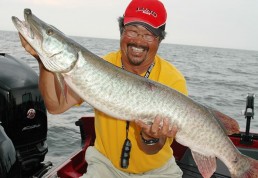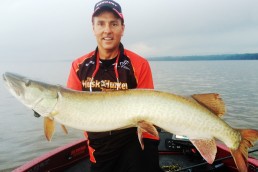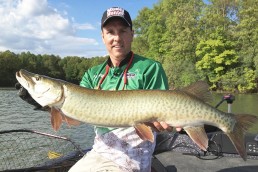Change Things up, Don’t Give up, for More Muskie Success
SHARE THIS POST
Forget the old wives’ tale that a muskie is a fish of a thousand casts. Increase your odds of catching the “king of freshwater fish” by following some of the following tips.
“Although muskies can be tough to find and catch, they have predictable movements,” said Dick Manske, who recently invented a new, innovative muskie-lure storage system, the Lure Bucket. “You are dealing with a small population of fish relative to other species of fish. But muskies can be predictable and you can put the odds in your favor.”
That may be hard to believe for many anglers who are often lucky enough to even see one fish per trip. But you’ll soon become a believer when you listen to Manske, whose personal-best muskie touched the ruler at 53 inches. He has a cabin on Leech Lake where he has caught hundreds of muskies ranging from 45 to 53 inches.
Manske believes muskies are extremely “territorial.” If you see a fish in a particular area, they will stick around. Take the time to learn their habits and anticipate their movements.
Recently, while fishing with Dick on Leech during a cold front in late September, two muskies were caught by us, and several others, and three fish also blew up on a surface lure, all in one day.
Muskies will often establish two home areas over the course of a year, with each range spanning 50 to 400 acres in size. One area is occupied in summer after water temperatures rise above 60 degrees; fish begin staging in their winter ranges later in the fall at 50 degrees and below. Muskies are on the move between these two transition periods.
Manske prefers to cast for them throughout the year. He believes that having the opportunity to see fish tells him that the fish are “interested,” but may not be in an aggressive mood. As the weather or light conditions change, he will return to those areas later with the confidence that they are still around.
Your odds of catching a fish on a huge body of water like Leech can be increased by sectioning the lake into smaller areas using some basic principles of structure fishing. Muskies are no different from other predator fish and will often be found on points, bars, humps, saddles or rocky shoals. Add some cover, like weed edges and weed points, and you’re in the right areas. Muskies use cover and structure for feeding and for resting.
Muskies will move very shallow at times, even during midday, where the warmer water makes them more active. The spots they use on any given day will often depend on factors such as wind direction, wave action, sunlight and forage movements. Use these same principles on your own home waters.
“The reality is that they can be tough fish to catch,” Manske said. “But, keep running and gunning to different high-percentage spots. You don’t just fish for muskies; you’re hunting for them.”
Are you enjoying this post?
You can be among the first to get the latest info on where to go, what to use and how to use it!
The interesting behavior of muskies is that they possess the characteristics of almost all of the key freshwater predator fish in North America. They are tentative and react to weather conditions like walleyes do, and will eat topwater baits and have home territories like largemouths. They are acrobatic and fight like smallmouths, and kind of look like northern pike but are not as aggressive. They are the biggest predator and at the top of the food chain, making them the “king of freshwater fish.”
Shallow or deep, casting or trolling, the point is this: When you catch a fish, take a good look at your lake map, find other places with similar features, fish there and repeat the tactic you were using when you caught the fish.
When you are casting, the “pool-cue” mentality for rods is not necessary. Start with an 8- to 8 1/2-foot graphite rod, one that will handle a 1- to 3-ounce bucktail spinner like St. Croix’s Legend Tournament Muskie Rod (LTMU86MHF). The rod should have some backbone, yet have a limber, fast-action tip in order to make it easier to cast big lures all day. Choose 80-pound-test super braided line like TUF Line XP, and then add a 12-inch metal leader.
Pack an array of baits including topwaters, bucktails, big spinners, jerkbaits and crankbaits. A complete arsenal allows you to fish the water column from top to bottom and offer the fish a choice of lures. Keep changing until the muskies tell you what they want. Dick uses the Lure Bucket to keep his lures organized and easy to change.
Don’t be discouraged when you get a muskie to “follow.” The fish that followed your lure just sent you a signal, “I’m almost ready to bite.” Remember what you exactly did to get the fish’s attention and think about what you can do differently to trigger a strike next time. Fine-tuning your presentation will often get that same fish to eat the next time.
“If I raise a fish, I will often catch it,” Manske says. “It may not be today or tomorrow, but I will catch her sometime—come back in a few hours or work the boat in a different direction, maybe throw something smaller or bigger, or a different style or color.”
Always vary the speed of your retrieve; don’t just assume that cold water needs a slower speed or that a fast retrieve is best in warmer water. End every cast you make with a sharp “L” turn or work your rod into a complete “figure-eight.” Always keep your eye just a few feet behind the lure looking for a fish that is following your lure. Once you see a fish, keep your lure moving and go right into a figure-eight motion. Swing your rod/figure-eight wide enough in order to allow the fish enough room to turn with the bait.
Your success rate can increase the more you understand a muskie’s behavior. Take care of every fish you catch in order to release it successfully. Big muskies are too rare to be caught just once. Take pictures, get a good measurement of the length and girth, and let it go. Always get the fish back into the water as soon as possible. When taking pictures, support its weight with a hand under its midsection.
If you take the time to understand these incredible creatures, you’ll soon become a muskie “master” and experience the thrill of catching the king of freshwater.
MWO
SHARE THIS POST
Did you enjoy this post?
You can be among the first to get the latest info on where to go, what to use and how to use it!
Ted Takasaki
Ted Takasaki is an International Fishing Hall of Fame professional angler who has been featured in many national outdoor magazines and television shows. Takasaki has appeared in front of thousands of angling enthusiasts and is considered one of America’s top walleye and multispecies anglers. Follow him on his Facebook page.




